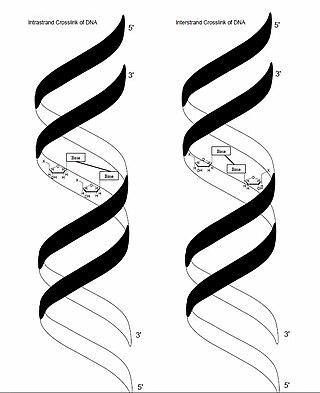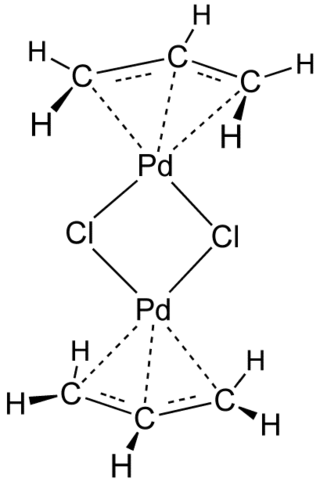Bioinorganic chemistry is a field that examines the role of metals in biology. Bioinorganic chemistry includes the study of both natural phenomena such as the behavior of metalloproteins as well as artificially introduced metals, including those that are non-essential, in medicine and toxicology. Many biological processes such as respiration depend upon molecules that fall within the realm of inorganic chemistry. The discipline also includes the study of inorganic models or mimics that imitate the behaviour of metalloproteins.

Cisplatin is a chemical compound with formula cis-[Pt(NH3)2Cl2]. It is a coordination complex of platinum that is used as a chemotherapy medication used to treat a number of cancers. These include testicular cancer, ovarian cancer, cervical cancer, bladder cancer, head and neck cancer, esophageal cancer, lung cancer, mesothelioma, brain tumors and neuroblastoma. It is given by injection into a vein.

In coordination chemistry, metal ammine complexes are metal complexes containing at least one ammonia ligand. "Ammine" is spelled this way for historical reasons; in contrast, alkyl or aryl bearing ligands are spelt with a single "m". Almost all metal ions bind ammonia as a ligand, but the most prevalent examples of ammine complexes are for Cr(III), Co(III), Ni(II), Cu(II) as well as several platinum group metals.

Methane monooxygenase (MMO) is an enzyme capable of oxidizing the C-H bond in methane as well as other alkanes. Methane monooxygenase belongs to the class of oxidoreductase enzymes.

Julius Rebek Jr. is a Hungarian-American chemist and expert on molecular self-assembly.

In genetics, crosslinking of DNA occurs when various exogenous or endogenous agents react with two nucleotides of DNA, forming a covalent linkage between them. This crosslink can occur within the same strand (intrastrand) or between opposite strands of double-stranded DNA (interstrand). These adducts interfere with cellular metabolism, such as DNA replication and transcription, triggering cell death. These crosslinks can, however, be repaired through excision or recombination pathways.
Dioxygen complexes are coordination compounds that contain O2 as a ligand. The study of these compounds is inspired by oxygen-carrying proteins such as myoglobin, hemoglobin, hemerythrin, and hemocyanin. Several transition metals form complexes with O2, and many of these complexes form reversibly. The binding of O2 is the first step in many important phenomena, such as cellular respiration, corrosion, and industrial chemistry. The first synthetic oxygen complex was demonstrated in 1938 with cobalt(II) complex reversibly bound O2.
Christopher J. Chang is a professor of chemistry and of molecular and cell biology at the University of California, Berkeley, where he holds the Class of 1942 Chair. Chang is also a member of the Helen Wills Neuroscience Institute, a Howard Hughes Medical Institute investigator, adjunct professor of pharmaceutical chemistry at the University of California, San Francisco, and faculty scientist at the chemical sciences division of Lawrence Berkeley Lab. He is the recipient of several awards for his research in bioinorganic chemistry, molecular and chemical biology.
Amy C. Rosenzweig is a professor of Chemistry and Molecular Biosciences at Northwestern University. She was born in 1967 in Pittsburgh, Pennsylvania. Her current research interests include structural biology and bioinorganic chemistry, metal uptake and transport, oxygen activation by metalloenzymes, and characterization of membrane protein. For her work, she has been recognized by a number of national and international awards, including the MacArthur "Genius" Award in 2003.

A metallopharmaceutical is a drug that contains a metal as an active ingredient. Most commonly metallopharmaceuticals are used as anticancer or antimicrobial agents. The efficiency of metallopharmaceuticals is crucially dependent on the respective trace metal binding forms.
Platinum-based antineoplastic drugs are chemotherapeutic agents used to treat cancer. Their active moieties are coordination complexes of platinum. These drugs are used to treat almost half of people receiving chemotherapy for cancer. In this form of chemotherapy, commonly used drugs include cisplatin, oxaliplatin, and carboplatin, but several have been proposed or are under development. Addition of platinum-based chemotherapy drugs to chemoradiation in women with early cervical cancer seems to improve survival and reduce risk of recurrence.

Phenanthriplatin or cis-[Pt(NH3)2-(phenanthridine)Cl]NO3 is a new drug candidate. It belongs to a family of platinum(II)-based agents which includes cisplatin, oxaliplatin and carboplatin. Phenanthriplatin was discovered by Professor Stephen J. Lippard at Massachusetts Institute of Technology and is currently being developed by Blend Therapeutics for its potential use in human cancer therapy.
DNA-binding metallo-intercalators are positively charged, planar, polycyclic, aromatic compounds that unwind the DNA double helix and insert themselves between DNA base pairs. Metallo-intercalators insert themselves between two intact base pairs without expelling or replacing the original nitrogenous bases; the hydrogen bonds between the nitrogenous bases at the site of intercalation remain unbroken. In addition to π-stacking between the aromatic regions of the intercalator and the nitrogenous bases of DNA, intercalation is stabilized by van der Waals, hydrophobic, electrostatic, and entropic interactions. This ability to bind to specific DNA base pairs allows for potential therapeutic applications of metallo-intercalators.
Ann M. Valentine is an American bioinorganic chemist whose research focuses on biomineralization, the uptake and transport of metals and their medical applications in areas such as cancer research. She has received awards including the 2014 AICChemical Pioneer Award "for her outstanding contributions towards advancing the science of chemistry and impacting the chemical profession" and the 2009 Paul D. Saltman Award for Metals in Biology for "outstanding contributions to the field of metals in biology" and "groundbreaking work on the structures and reactions of complexes containing titanium."

Transition-metal allyl complexes are coordination complexes with allyl and its derivatives as ligands. Allyl is the radical with the connectivity CH2CHCH2, although as a ligand it is usually viewed as an allyl anion CH2=CH−CH2−, which is usually described as two equivalent resonance structures.
Samaresh Mitra is an Indian bioinorganic chemist and an INSA Senior Scientist at the Indian Institute of Chemical Biology (IICB). He is known for his research on inorganic paramagnetic complexes and low-symmetry transition metal complexes. He is an elected fellow of the Indian National Science Academy, the National Academy of Sciences, India and the Indian Academy of Sciences. The Council of Scientific and Industrial Research, the apex agency of the Government of India for scientific research, awarded him the Shanti Swarup Bhatnagar Prize for Science and Technology, one of the highest Indian science awards, in 1983, for his contributions to chemical sciences.
William B. Tolman an American inorganic chemist focusing on the synthesis and characterization of model bioinorganic systems, and organometallic approaches towards polymer chemistry. He has served as Editor in Chief of the ACS journal Inorganic Chemistry, and as a Senior Investigator at the NSF Center for Sustainable Polymers. Tolman is a Fellow of the American Association for the Advancement of Science and the American Chemical Society.
Karl Wieghardt is a German inorganic chemist and emeritus director of the Max Planck Institute for Chemical Energy Conversion in Mülheim. He was active in the preparation and detailed characterization of models for iron and manganese metalloenzymes, metal complexes of noninnocent ligands, and magnetic interactions in polynuclear metal complexes.
Deborah Beth Zamble was a Canadian chemist and Canada Research Chair in Biological Chemistry at the University of Toronto. Her research considered how bacteria processed metal nutrients.

In biochemistry, non-heme iron proteins describe families of enzymes that utilize iron at the active site but lack heme cofactors. Iron-sulfur proteins, including those that are enzymes, are not included in this definition.












